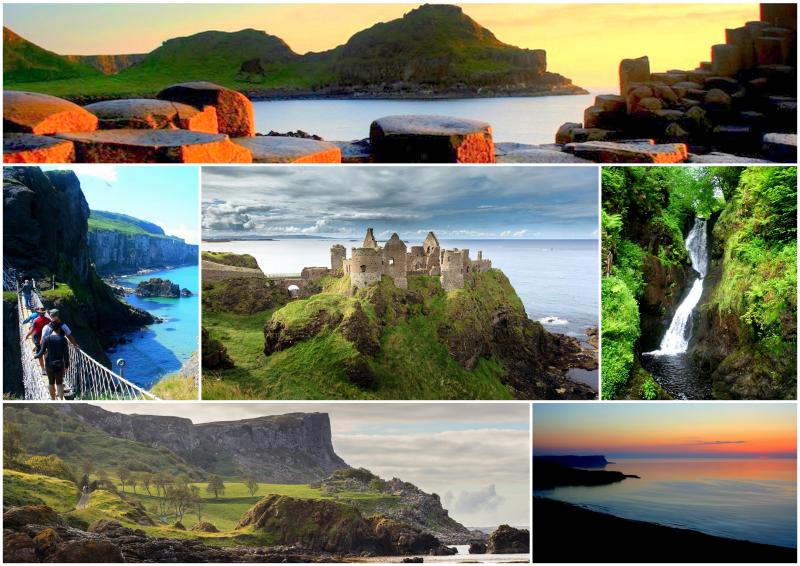
Antrim Glens & Coastline: Trail Info
Introduction
Our Antrim Glens & Coastline tours are located in County Antrim, situated in the northeast of the island of Ireland. Antrim is one of six counties that form Northern Ireland, and is therefore part of the United Kingdom of Great Britain and Northern Ireland.
Our Antrim itineraries predominantly follow the ‘Ulster Way’ (a 1,000km/625 mile long circular official long distance walking route around Northern Ireland), while also including some additional non-waymarked sections. The route takes in many Areas of Outstanding Natural Beauty, which are defined in the UK as an outstanding landscape whose distinctive character and natural beauty are so precious that it is in the nation’s interest to safeguard them.
The trail covers some world-renowned spots, such as the Giant’s Causeway, Dunseverick Castle and Dunluce Castle, and you will also see some recognisable locations from the hit television show, Game of Thrones. From the coastline, you will get glimpses of the distant Mull of Kintyre in Scotland, as well as numerous islands dotted around the coastline.
Map
The Route
From Cushendall to Ballycastle the trail follows the ‘Moyle Way’ section of the Ulster Way. The trail goes through the scenic woodlands and rivers of Glenariff Forest Park before heading north through the Glens of Antrim over remote upland and then through forestry towards the town of Ballycastle.
Next, you take the stunning cliff walk from Torr Head/Murlough Bay around Fair Head, with views towards Scotland, back to Ballycastle along an unofficial trail. On a day-trip to Rathlin Island, we suggest some unofficial walks to explore the island and its varied history and wildlife.
From Ballycastle, farm and forestry tracks and minor roads lead to the small village of Ballintoy and the famous Carrick-a-Rede Rope Bridge. Continuing west from Ballintoy, the trail follows the ‘Causeway Coast Way’ section of the Ulster Way along the most celebrated stretch of coastline in Northern Ireland.
The route leads to Dunseverick Castle and then on to the world-famous Giant’s Causeway. The world’s oldest Whiskey distillery, located at Bushmills, is just a short detour from the trail at this point. From here, the trail follows the coastline, passing through the coastal villages of Portballintrae and Portrush, past the impressive ruins of Dunluce Castle, to the Victorian seaside town of Portstewart.
Terrain Overview
There is a wide range of terrain to experience along this trail. There are forest trails, upland moorland paths, cliff sections, beach walks, promenade strolls and some occasional road links.
Only the Moderate tour itineraries cover the more challenging Moyle Way mountain sections in the Antrim Glens, i.e. the hikes from Waterfoot/Orra Beg to Glenariff Forest Park and from Orra Beg to Ballycastle. Those sections cover more remote countryside and reach the highest elevation of the walk (500m) at Sleaveanorra (Orra More). Those sections can be wet and rough underfoot, and navigation can become a little more challenging in bad weather.
Our Gentle itineraries focus on the Antrim Coast and can be enjoyed by the novice walker as well as the more accomplished hiker. The highest point on the coastal section of the trail is approximately 180m above sea-level and none of the off-road sections are very remote.
The total aggregate ascent is approximately 1,200m for the Antrim Glens section and 740m for the Antrim Coast section and it includes only a few short but steep climbs, specifically on the moderate tours.
Elevation Profiles (not including Rathlin Island) (Click image to enlarge)
Antrim Glens (Waterfoot to Ballycastle - 42km)
Antrim Coast (Torr Head to Portstewart - 62km)
Terrain by Stages
Waterfoot - Glenariff Forest Park: Flat, grassy riverside paths and quiet rural lanes at the beginning, followed by a climb to 250m on woodland trails in the forest park. Along this route are waterfalls, forest trails and riverside walks.
Orra Beg - Glenariff Forest Park: A gravel track climbs through forest towards open mountainside. Descent along a faint footpath over moorland, then a climb up the slopes of Trostan (550m). The route enters more sheltered forest tracks to the forest park. Can be very wet in places, often with fallen trees and many streams.
Orra Beg - Ballycastle: Secluded forest tracks and riverside paths (can be wet under foot). Climb up to a forest and nature reserve. Quiet country roads along slopes lead to tracks through Ballycastle Forest and on to Ballycastle town. A few short, sharp ascents in the forests.
Torr Head - Ballycastle: A steep climb along quiet roads, followed by a walk on deserted roads or along the coastline on a cross-country route. Clifftop trails lead around Fairhead. The route then descends to sea-level and follows a path which can be overgrown and is rugged in places. An alternative route follows minor roads.
Rathlin Island: A choice of three routes to the east, west and south lighthouses. The walks follow quiet island roads, tracks and paths. The east and south routes are gently sloping without any significant elevation change. The west route climbs steadily from sea level to the cliffs and seabird colony at the West Lighthouse.
Ballycastle - Ballintoy: Minor roads out of Ballycastle lead onto farm and forest trails. These can be wet and/or overgrown. A gentle slope keeps climbing along minor roads before the route drops down to join the coastal path to the Carrick-a-Rede rope-bridge.
Ballintoy - Giant’s Causeway: A small road followed by a trail that heads along the bottom of cliffs to a long beach walk. This beach walk ends with a climb over boulders. From here, the trail leads along the foot of some cliffs to a path which frequently climbs and descends along the cliffs. Finishes with a walk along a cliff-top path.
Giant’s Causeway - Portstewart: A mixture of beaches, urban paths and roads. From Portballintrae, a section of road walking, followed by a gravel path and then a stretch of strand. After this, urban footpaths and trails lead to a promenade walk. The trail finishes with a section of cliff-top and coastal paths.






